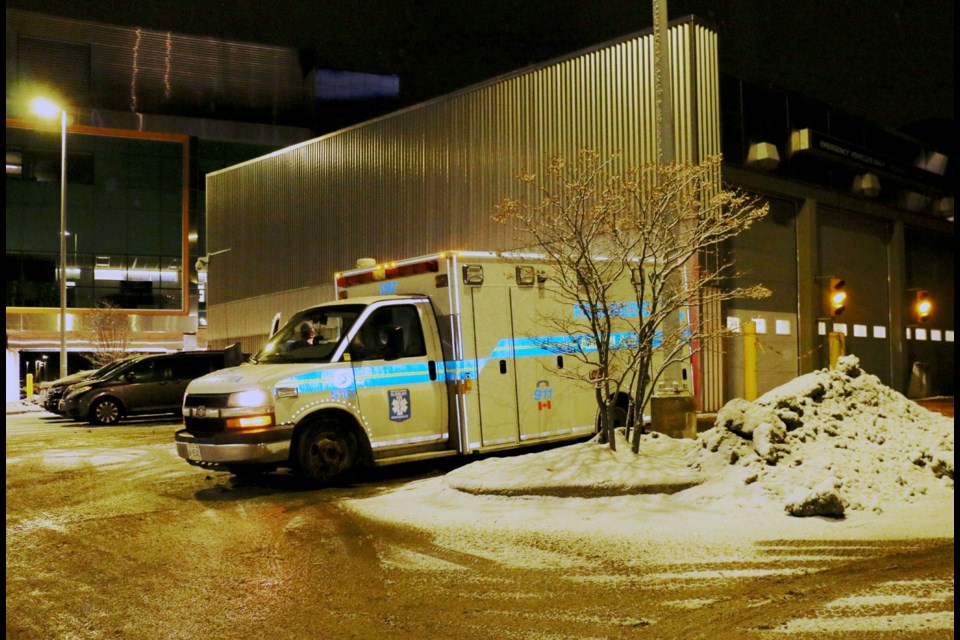A report from Greater Sudbury Paramedic Services (SPS) said that Ambulance Offload Delay (AOD) is costing the service huge amounts of time and money every year because overcrowding in the hospital emergency department doesn't allow paramedics to transfer their patients in a timely manner.
The delay issue was the subject of a detailed report recently presented to Greater Sudbury city council.
"A delay in the transfer of patient care from paramedics to the Health Sciences North (HSN) Emergency Department staff thereby trapping paramedics in the Emergency Department for extended periods," said the Sudbury report.
Any transfer of care that takes 10 minutes or longer is an AOD, said the report.
Under the law in Ontario, paramedics may not leave a patient at the emergency room until there is a formal transfer of care to medical staff at the hospital.
Until that happens, the paramedics must stay with the patient in the emergency room and keep that patient on the stretcher.
"The principal cause of an AOD is a lack of in-patient bed capacity, leading to prolonged Emergency Department length of stay and overcrowding," said the report.
It also said that the delay in turnaround time is having a significant impact on the efficiency of the local paramedic operations.
"Paramedic Services data indicates that in 2021, Sudbury Paramedic Services spent approximately 3,678 hours at the hospital on AODs. This is equivalent to removing one ambulance from service for 10 hours every single day of the year," said the report.
"The direct value associated with this loss of deployment is $417,901 (two paramedics, 10 hours day/365 days; salary and benefits)," the report continued.
The report noted HSN is the only emergency department within our region to treat emergent patients. There are also ambulances that bring new patients to the HSN emergency room from a wide area across Northern Ontario, putting additional strain on in-patient bed capacity.
"The emergency department has seen a return to pre-pandemic volumes with a projected number of visits for 2021-2022 of 75,753. With only one emergency department located at HSN for our region, during periods of high ambulance call volumes or significant AODs, paramedics have no alternative emergency department to divert acute ambulance patients," said the report.
It also said that the call volume for patients using the EMS 911 service has increased.
"Over the past 10 years the call volume of patients using 911 has increased by approximately 2.9 per cent every year. Throughout the pandemic call volume fluctuated but has now returned to pre-pandemic levels. In 2021 the call volume for patients using 911 was 32,236," said the report.
Another concern outlined in the report is that there are still many cases of transfers of non-emergency patients from other care facilities to the hospital, which puts a strain on the system.
"There are many reasons why patients need to be transported from one health-care service location to another. During non-urgent transfers, the patient is not in immediate danger. The majority of these transfers are for routine, non-life-threatening reasons but regularly utilize 911 emergency resources. This practice diverts emergency resources from more urgent 911 requests." said the report.
Other impacts outlined in the report were that the delays make it harder to provide balanced emergency coverage across the city; that the delays increase emergency response times; that it delays the time in getting truly sick patients to the emergency room, that it creates late or missed meal breaks for the paramedic officers and that it creates overtime demands during shift changes.
There are mitigation efforts in place, said the report. One is having a dedicated AOD nurse on duty to accept ambulance patients. This program, which has been in place since 2013 relies on $216,000 of provincial funding and provides AOD nurses daily from 10 a.m. to 10 p.m. This allows nurses to accept three or four patients a day.
Another option that is used is the fit-to-sit program, meaning that if an ambulance patient is not critically ill, that patient can be transferred to the emergency waiting room to sit in a chair to wait his or her turn.
The report concluded with the paramedic service saying it will continue to explore options to resolve the problem.
"Paramedic Services continues to collaborate with MOHLTC (Ministry of Health and Long-Term Care), community partners and HSN to implement mitigation strategies to address the increasing number of AODs within the HSN emergency department."
As dire as this sounds, the Sudbury Paramedic Service is not performing as poorly as many other Ontario communities. The Sudbury paramedics report quoted the most recent statistics from Municipal Benchmarking Network (MBNCanada) that show the percentage of ambulance time lost to hospital turnaround was hovering at 10 and 11 per cent for the years 2017, 2018 and 2019. Sudbury has the lowest time on the chart.
For the same period, Toronto was higher than 25 per cent of lost time. Similar statistics were reported for Hamilton, Thunder Bay and Winnipeg.
